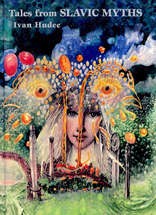Mythology looms large in understanding the origins of a culture. Myths and legends reveal a people's innermost character, feelings, fears and desires. Thus, to understand the nature of Slavic peoples in its totality, one needs to look to Slavic mythology as it existed before the advent of Christianity.
Most scholars in the English-speaking world have paid scant attention to Slavic mythology, and hitherto, just a handful of journal articles have touched on the subject. As a result, we have lacked a real understanding of the character of pre-Christian Slavic culture.
This book marks an attempt to fill this gap. It represents the first collaborative narrative about Slavic mythology in the English language.
Piecing together myths
Unfortunately, unlike the Greeks, the pagan Slavs had no Homer who recorded early Slavic myths in epic literature. What we know about Slavic mythology is based upon oral traditions and scattered references in ancient texts. Artifacts from archaeological excavations have provided researchers with solid evidence that mythology played an integral role in early Slavic culture.
Many of these myths, as well as the customs associated with them, continued to exert a significant influence among the Slavic peoples long after the dawn of Christianity, which strove to suppress all manifestations of the Slavs' pagan past.
The book begins by familiarizing readers with the hierarchy of the Slavic pantheon of gods and their nature. Although having some human characteristics similar to the ancient Greek divinities, these creatures don multiple heads and even take the shape of animals. They can behave mischievously at times, but order is kept by Svarozhich, the supreme deity and son of the sleeping Svarog, the creator of the universe.
The story continues with the creation of the world and ultimately the Slavic man. It elaborates on his relationship with the gods, various forms of worship, and his battles with the Nemtsi (the dumb, or Germanic, peoples who did not speak the Slavic language). The narrative concludes with a theme prominent in the mythology and literature of many peoples—man by his conceit, hubris and reckless disregard for the gods is left to fend for himself, and is subject to the whims of demons and ill fortune.
In each section, the editors include extensive explanations, which further enlighten us with supportive details about the myths. These help the reader make connections with the ongoing Slavic customs which persisted in new forms after the conversion of the Slavs to Christianity. For instance, we learn that the Slavic people's famous colored Easter eggs, pysanky, owe their origins to Slavic mythology.
The story behind the book
While the book fills an enormous gap in the literature available in English on Slavic mythology, it still has a few shortcomings. There is no preface to provide valuable background information about the author, Ivan Hudec, and his research in writing this book. During the 1990s, Hudec served as a very controversial minister of culture under the government of then prime minister Vladimír Mečiar.
He originally wrote the book in 1947 under the title, Báje a mýty starých Slovanov (Tales and Myths of the Ancient Slavs). It would be interesting to find out more specific detail about Hudec himself and the sources he used. How well was the book received at the time of its publication?
Hudec's work has stood the test of time. Dušan Caplovic, a preeminent anthropologist of the Slovak Academy of Sciences, acknowledged that this is a solid piece of scholarship using a vast array of sources from Central and Eastern Europe. It has provided us with an insight into the spiritual life of the pre-Christian Slavic world, which stretched from the Volga to the Elbe Rivers, and from the Baltic to the Black and Mediterranean Seas.
For those interested in pursuing the topic further, the book contains a selective bibliography of sources on Slavic mythology in English. A map of ancient Slav settlements and archaeological sites provides a useful source of reference for place names. The book also has an index of the pantheon of Slavic deities and demons. Each god or demon is explained according to his or her responsibilities and ranking.

|




